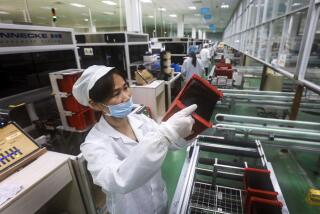Concessions Open Door in China to U.S. Exports : Trade: Beijing and Washington formally sign major accord eliminating most Chinese import roadblocks.
WASHINGTON — China has agreed to sweeping new economic concessions designed to eliminate most of its import quotas, trade restrictions, controls and licensing requirements on U.S.-made products over the next five years, the White House said Saturday.
The move, part of a major new trade accord formally signed by U.S. and Chinese negotiators, is expected to open the way for billions of dollars of additional U.S. exports to China on products ranging from computers and auto parts to medical equipment.
Completion of the new pact, announced by the White House and the U.S. Trade Representative’s Office, will head off retaliatory tariffs of up to 100% on Chinese goods that Washington had threatened to impose if Beijing had not signed the accord.
In return for the concessions, the Administration said it will help speed approval of China’s application to join the 102-country General Agreement on Tariffs and Trade, the Geneva-based organization that governs the global trading system.
U.S. officials announced Friday that they had reached an agreement “in principle” to settle the trade dispute, but they withheld details until senior officials in Beijing approved the accord Saturday.
Bush Administration officials have been hoping that the accord, which has taken several months to negotiate, would help bolster the President’s flagging reelection campaign. Private analysts said Saturday that the agreement is a significant achievement.
China has become an important trading country over the last decade as a result of a steady liberalization of its Marxist-model economic policies, with its two-way trade worldwide totaling $165 billion this year and likely to rise to $200 billion or more in 1993.
Michael H. Moskow, the deputy U.S. trade representative, told reporters Saturday that the new Chinese concessions--which he labeled “unprecedented”--will bring China into the mainstream of trading nations and satisfy Washington’s major trade complaints against Beijing.
U.S. officials said the accord contains these major elements:
* China will reduce tariffs significantly on a wide variety of imports between now and December, 1993, including chemicals, machinery, electrical parts, film products, instant cameras, steel, confectionery goods, cosmetics, fruits and nuts.
* It also will phase out the “vast majority” of trade restrictions--ranging from quotas and controls to import-licensing requirements--on foreign products in line with a “strict, short schedule” aimed at eliminating 75% of them within two years.
Among the products expected to be affected will be computers, auto parts, instant cameras, air conditioners, integrated circuits, photocopiers and medical equipment. Restrictions on imports of digital equipment will be eliminated by March 31, 1993.
* From now on, China will publish all of its laws, regulations, policies and official “guidance” dealing with import and export procedures and will make detailed commercial information available to interested businesses. Such laws have been kept secret, hindering U.S. companies trying to operate in China.
* Beijing will eliminate China’s “import-substitution” system, under which Chinese manufacturers have been forbidden to buy imported products or supplies whenever China could take steps to begin producing similar products of its own.
* China will end the practice of using sanitary and health standards as a ploy to keep out foreign agricultural products. Under the new accord, Beijing has promised to base all such laws on generally accepted scientific standards.
* U.S. auto manufacturers engaged in joint ventures with local enterprises in China no longer will be impeded in procuring parts and assembly kits from their home countries. In the past, China has restricted the access of these companies to foreign-made supplies.
Settlement of the trade dispute with the United States is expected to prove a major relief to the Beijing government. Had Washington imposed the retaliatory duties that it had threatened, prices of many Chinese-made products would have doubled, crimping sales severely.
Moskow announced Saturday that the Administration will withdraw the formal trade complaint that it had filed against the Chinese government last year under Section 301 of the 1974 trade act. But he said Washington will continue to monitor Beijing’s performance.
U.S. unhappiness with China’s trade restrictions had intensified in recent years as Beijing’s exports here mushroomed while U.S. sales in China grew only modestly. The U.S. trade deficit with China is expected to reach $20 billion this year.
The trade talks had been put on hold earlier this year after Beijing became irked over Bush’s decision earlier this fall to permit the sale of U.S.-made F-16 jet fighters to Taiwan. But the Chinese apparently decided to sign the trade pact, anyway.
China agreed in a separate accord a year ago to abide by international agreements governing intellectual property, which involves copyrights, patents and trademarks. In that dispute, too, the Bush Administration had threatened to impose retaliatory tariffs on Chinese goods.
The Administration has argued that negotiations over the two pacts would prove more effective than requiring China to liberalize its trade laws as a condition for U.S. renewal of most-favored-nation trade status for China--a position favored by the Democrat-dominated Congress.
More to Read
Sign up for Essential California
The most important California stories and recommendations in your inbox every morning.
You may occasionally receive promotional content from the Los Angeles Times.









